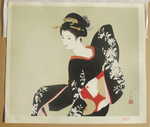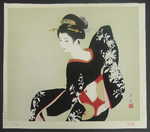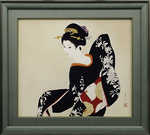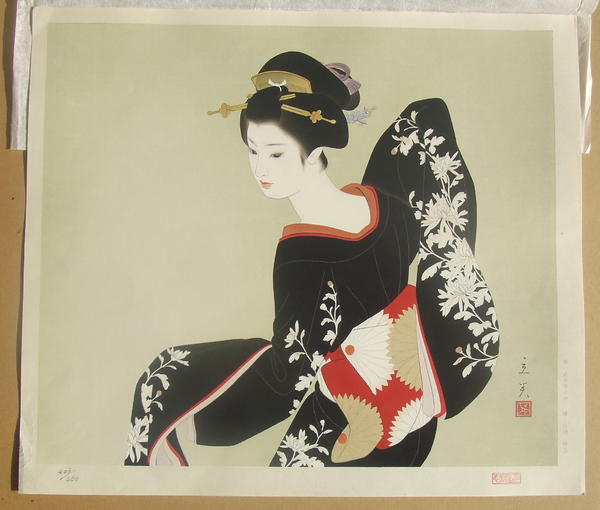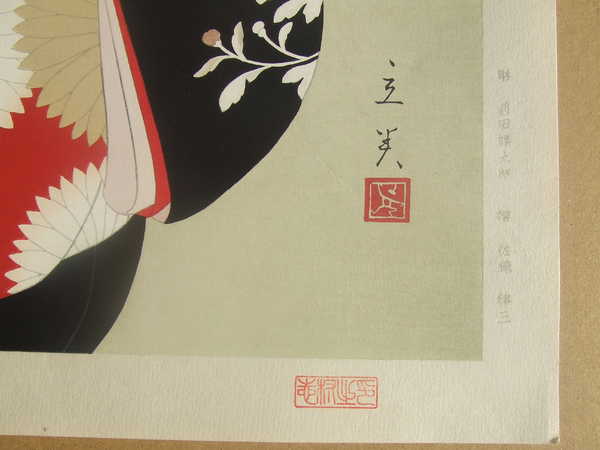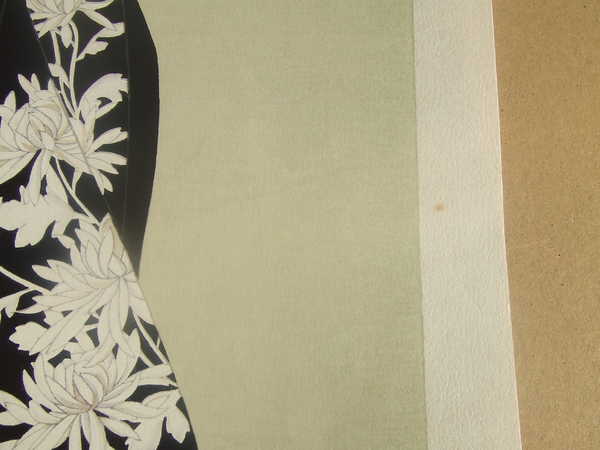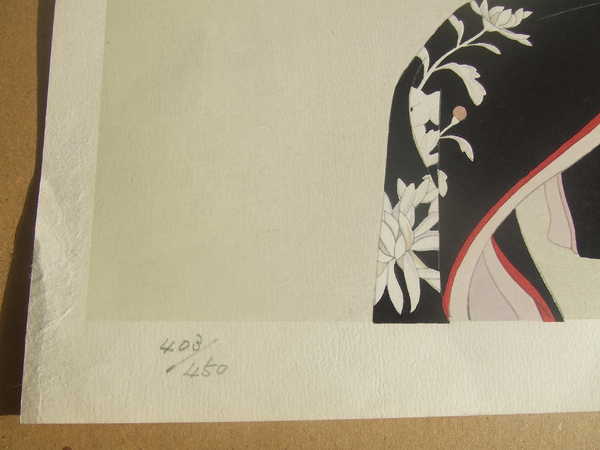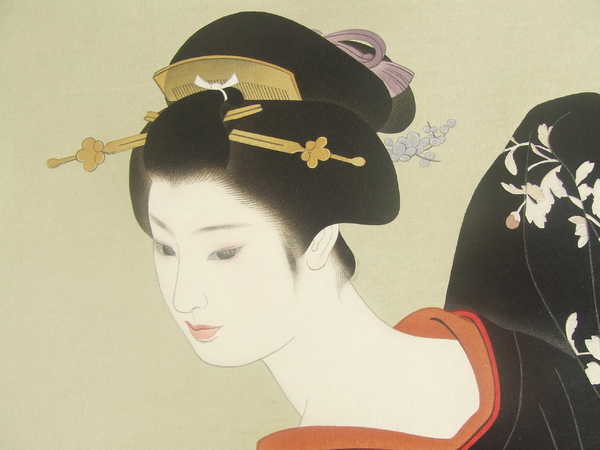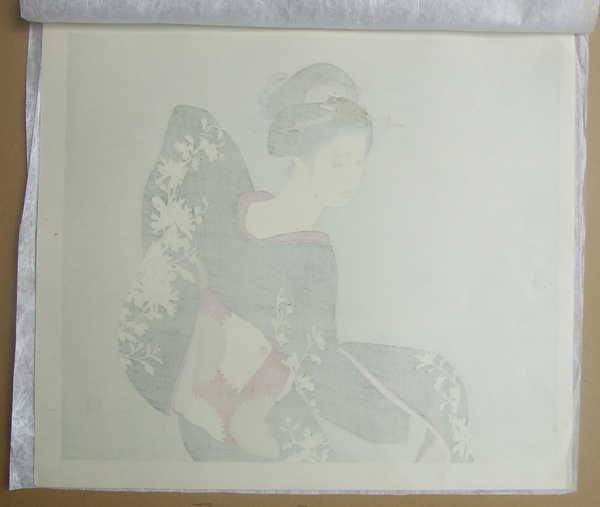| | |
| Artist: | Shimura Tatsumi (1907-1980) — 志村立美 |
| Title: | Dance- gesture — MAI- Shigusa |
| Series: | |
| Date of first edition?: | 1970 (in the decade of) |
| Publisher (first edition)?: | Yuyudo — 悠々洞出 |
| Publisher (this edition)?: | Yuyudo — 悠々洞出 |
| Medium (first edition): | Woodblock |
| Medium (this edition): | Woodblock |
| Format (first edition): | Double Oban
|
| Format (this edition): | Double Oban |
| DB artwork code: | 39709 |
| Notes (first edition)?: |
There are two different editions for this scene:
(1) the original scene published as a woodblock print by Yuyudo in the 1970s/80s, and
(2) the same scene published as a Giclee print by Inter Art Limited in 2009. It is titled Shigusa 2 (Dance 2). |
|
| Notes (this edition)?: |
| The following information was taken from the original web listing of this artwork. Note that there may be some inaccuracies:
Friday, 15 September 2006
"MAI" (dance) this extremely rare woodblock by Tatsumi Shimura (1907-1980). Limited Edition 403 of 450. Rarely seen in Japan and nearly impossible to find outside of Japan as Tatsumi prints are extremely rare, highly cherished in Japan and seldom sold. I do not think this print has ever been seen outside of Japan. Tatsumi specialized in bijin ga - prints of beautiful women. He is most famous for his series "Five Figures of Modern Beauties".
This limited edition print is numbered 403 of 450. The title is "MAI" but this print is well known as "Shigusa" (gesture) because Tatsumi say; "This picture is a scene of a Japanese dance. Most take in a figure of the woman I (Tatsumi) draws me from Japanese dance. As for the moment to a thing swing and dance is beautiful really wonderful."
Carver; Kentaro Maeda, Printer; Ritsuzo Sato, and Publisher; Nihonkougei Bijutsuin. Red seal in lower margin reads, "Sekiha no In". Size is large: paper size is 19 inches by 16 and 1/4 inches. Colors are fresh, vivid and vibrant. . Absolutely stunning original hand Japanese made woodblock print. Outstanding condition, one tiny foxing noted well into the right margin, tiny paper crease near Tatsumi’s official seal. Please note it appears this was once tipped to presentation folder also well into the lower left margin. Thin Japanese washi backing paper attached to verso. Additional pictures gladly provided upon request.
The quality, colors and exquisite nature these Japanese woodblock prints can not be fully appreciated with these inferior pictures. The colors and details are much better. Buyers of these prints will not be disappointed. These prints will provide you with years of pleasure and pride of ownership
|
|
| Artist Bio: |
Tatsumi Shimura is known for designing several striking bijin-ga prints towards the end of the Shin Hanga movement. Born in Takasaki, Gunma, Shimura's real name was Sentaro. In 1921, he began studying art with Yamakawa Saiho, a well-known illustrator. Three years later, he became an apprentice of Saiho's son, Yamakawa Shuho, who was also a bijin-ga artist. Shimura exhibited paintings with Kyodotai in 1927 and with Seikinkai in 1938. He became known for his paintings of beautiful women with long eyelashes and blurred pupils. As a young man, Tatsumi also worked as an illustrator for newspapers, serialized novels, and magazines, notably for the Japanese magazine "Woman's world" (Fujokai). His most famous illustrations were for the novel Tange Sazen by Hayashi Fubo. From 1948 to 1952, Shimura designed several woodblock prints of beauties that were published by Kato Junji. Later he collaborated with the Japanese Institute of Prints (Nihon Hanga Kenkyusho) to create a series called "Five figures of modern beauties" (Gendai bijin fuzoku gotai). These prints were first published in 1953 in an edition size of 200 and contain a thin red rectangular Gihachiro supervisor seal (Okuyama Gihachiro was the founder of the publisher). The series was later reprinted using recarved blocks in the 1960s/70s/80s in other edition sizes of 100, 200, and 300, plus an open (unlimited) edition (see here for further details). They depict Japanese women in traditionally feminine poses and attire. The finely detailed figures are juxtaposed against very simple backgrounds. Tatsumi later published various other gorgeous bijin-ga in double-oban size via the publisher Momose in the 1980s.
志村立美(しむら たつみ、1907年2月17日 - 1980年5月4日)は、日本画家、挿絵画家・ 美人画家である。群馬県高崎市生まれ。本名 仙太郎。群馬県高崎市生まれ。 神奈川県立神奈川工業高等学校図案科を中退して、1924年(大正13年)山川秀峰に入門美人画を修める。 当時、山川秀峰は鏑木清方と伊藤深 水と共に、挿絵での活動もしていた。 山川秀峰の推薦を受け、立美も挿絵での活動を行うようになる。肉筆画も鏑木清方主宰の郷土会、師である山川秀峰、伊東深水らの主宰する青衿会等へ出品をする。 その後主婦の友・婦女 界などの雑誌口絵などでその名を知られるようになり、林不忘原作の丹下左膳の挿絵などで岩田専太郎と並ぶ人気画家となる。晩年、挿絵での活動を休止し、本来の立美の原点である日本画、美人画への回帰をしていく。 出版美術家連 盟会長などをつとめ、1976年(昭和51年)作品集『美人百態』で日本作家クラブ賞を受賞する。「現代女性十二態 花吹雪」 木版 東京国立近代美術館所蔵 |
|



